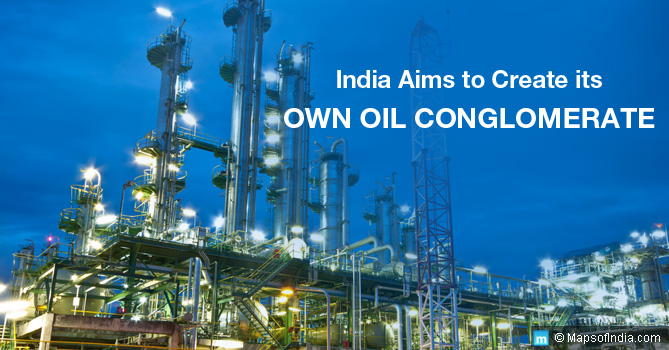“We propose to create an integrated public sector oil major which will be able to match the performance of international and domestic private sector oil and gas companies,” – Arun Jaitley, Finance Minister of India in budget speech (February 1, 2018)
India plans to merge 13 oil companies to create oil giant and take on global rivals.
- In his budget speech, Finance Minister (FM) Arun Jaitley said that in 2017-18 India would “create an integrated public sector oil major”. This idea has been afloat for a few months. India plans to merge its oil companies to create a behemoth and tackle global rivals like Exxon Mobil, Chevron, Royal Dutch Shell, and BP.
- India is the world’s third largest oil consumer and imports about 80 percent of its oil needs. According to the International Energy Agency, India will account for one-fourth of the global energy use by 2040. In 2015, Prime Minister Narendra Modi swore to reduce this dependence on imports to 67 percent by 2020. India is now looking at acquiring a number of foreign oil assets.
- There are a number of small oil companies in India. The more well known among these are Indian Oil Corporation (IOCL), Hindustan Petroleum Corporation (HPCL), and Oil and Natural Gas Corporation (ONGC). Their scale and financial strength, however, does not allow them to explore many overseas assets.
- By combining them and creating a single oil giant we “will give them capacity to bear higher risks, avail economies of scale, take higher investment decisions and create more value for shareholders”, said the FM. This indicates that India is looking forward to bid for foreign exploration and step up domestic production in the months to come.
- It is not clear yet if India will integrate all 13 oil firms into one corporation or only a few will be combined.
- Upstream oil companies (oil producers) like GAIL, ONGC, and OIL together have a combined market capitalisation of Rs 3,45,033 crore. This adds up to a combined revenue of Rs 1,39,967 crore and profits worth Rs 20,633 crore. Downstream oil firms (refineries and fuel marketing firms) BPCL, IOCL, and HPCL together have a market capitalisation of Rs 3,37,112 crore. This adds up to revenues worth Rs 7,19,477 crore and profits amounting to Rs 21, 649 crore.
- These six companies combined will give the new oil giant market a capitalisation of Rs 6,82,145 crore which translates into US$97.4 billion. The new company will then have a revenue of Rs 8,59,444 crore or US$122.7 billion and profits amounting to Rs 42,327 crore.
- This will make the new company India’s most profitable company and make it a formidable rival for companies such as BP (UK oil company) which has a market capitalisation of US$115.5 billion and Russia’s Rosneft which has a market capitalisation of US$70 billion.
- The idea is certainly not a new one. Some 12 years ago, in 2005, the erstwhile Oil Minister Mani Shankar Aiyar had proposed the merger of 5 companies HPCL, BPCL, OIL, IOC, and ONGC to create two oil giants to create more oil interests and assets. The proposal had been turned down at the time.
- The Finance Minister also announced plans to set up two more strategic oil reserves – one in the state of Odisha and another in Rajasthan. These will be in addition to the three reserves currently in use in the country.
- The three oil reserves in use at the moment are capable of holding 5.33 million metric ton (MMT) of strategic reserves. With the construction of the two new ones India’s capacity to hold strategic reserves will go up to 15 MMT.
- The oil reserve caverns are maintained by the Ministry of Petroleum and Natural Gas administered Indian Strategic Petroleum Reserves Ltd (ISPRL). Foreign oil companies are already in negotiation with ISPRL to store their oil in Indian vaults.
- In a move to insulate itself against energy security threats, Indian government is building underground storage sites in the country which will be capable of holding oil amounting to about 10 days of daily demand.
- To promote the use of natural gas, the Finance Minister also announced a slash in the import duty for Liquefied Natural Gas (LNG) from 5 percent to 2.5 percent. “Considering the wide range of use of LNG as fuel as well as feedstock for petrochemicals sector, I propose to reduce the basic customs duty on LNG from 5 percent to 2.5 percent”, the FM had said.




